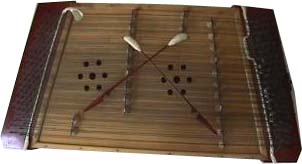
As music major, I am always fascinated to hear and learn about instruments around the world. And while reading about Hutsul’s Folk Art and Music, I had a strong urge to look deeper into finding out specific instruments from the Carpathian region in Southwestern Ukraine: particularly among the Hutsuls.
Tsymbaly is a Ukrainian version of a hammered dulcimer (cimbalom), a chordophone made up of a trapezoidal box with metal strings. Groups of three to five stings are tuned in unison, which are stretched between two bridges on the soundboard and is played by striking two wooden beaters against the strings. The origin of tsymbaly can be traced back to the Middle East where it was known as the Persian santur, which was brought into Ukraine during the Crusades. However, the first recorded evidence of the tsymbaly only dates to 17th century. Since then, it spread in popularity among people in the Carpathians in Southwestern Ukraine (specifically among Hutsuls and Bukovynians).

Tsmbaly have rich musical range of sounds and attain melodic, harmonic, and rhythmic functions as well. It is often used in folk ensembles called Troyista muzyka but also popular as a solo instrument.
Another interesting fact I have found was that as Ukrainians immigrated to Canada during WWI-WWII, tsymbaly became extremely popular in Western Canada where annual contests are still held in the beginning of August.
This is a video of a Hutsul Tsymbaly performance. The camera is rather shaky in the beginning but I hope you enjoy seeing and hearing an instrument from the other side of the world! (He is playing an Ukrainian melody from Hutsúlshchina (southwestern Ukraine).)
No comments:
Post a Comment